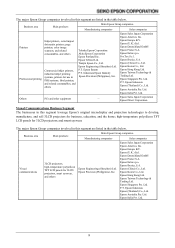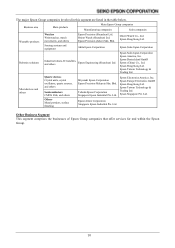Epson 2016 Annual Report Download - page 18
Download and view the complete annual report
Please find page 18 of the 2016 Epson annual report below. You can navigate through the pages in the report by either clicking on the pages listed below, or by using the keyword search tool below to find specific information within the annual report.
17
possibility that other companies could use their brand power, technological strength, ability to procure funds,
marketing power, sales skills, low-cost production ability, or other advantages to enter business areas where we are
active.
3. Sudden changes in the business environment could affect Epson.
Epson seeks to drive inkjet innovation, visual innovation, wearables innovation, and robotics innovation. We are
looking to achieve our vision for each business by providing value to customers in the form of smart technologies,
environmental benefits, and functional performance. Epson is executing plans and strategies based on a long-range
corporate vision and a mid-range business plan that we believe will enable us to establish a competitive advantage
in technology, which believe will be crucial for increasing our competitiveness. We are driving further advances in
our original core technologies, including Micro Piezo inkjet technology, microdisplays, sensing, and robotics, all of
which arose from the efficient, compact, and precision technologies that have become a part of Epson’s DNA over
many decades. By combining these technologies to create platforms, we are developing, manufacturing, and selling
products and providing services that match customer needs.
However, in the product markets and businesses where Epson is concentrating its management resources the pace
of technological innovation is typically rapid, and product life cycles are short. In addition, demand and investment
trends in Epson’s major markets could change along with global economic conditions and could affect sales of
Epson products. Moreover, there is no guarantee that the mid-range business plan and business strategies that
Epson is currently pursuing will succeed.
Epson will also strive to make rapid and smooth transition from existing products to new products by
understanding market and customer needs, investing and conducting research and development from a medium-
and long-range view based on product market forecasts, and creating development and design platforms.
However, if Epson cannot suitably respond to technological innovations in its main markets, or if economic
downturns or other factors prevent a recovery in demand, or if Epson is unable to adequately meet sudden
fluctuations in demand in a major market, its operating results could adversely be affected.
4. Our revenue and earnings could be adversely impacted by sales of third-party inkjet printer
consumables.
Ink cartridges, which comprise the bulk of consumables sold for inkjet printers, are an important source of revenue
and profit for Epson. However, third parties also supply ink cartridges and other inkjet printer consumables that can
be used in Epson printers. These alternative products are typically sold for less than genuine Epson brand
consumables and are more prevalent in emerging markets compared to the markets of developed countries.
To counter sales of third-party consumables for inkjet printers, we must emphasize the quality of genuine Epson
products and must look to continuously realize customer value by further enhancing customer convenience with
inkjet printers tailored to the needs of customers in each market. Printer models equipped with high-capacity ink
tanks are an example of such products. We also take legal measures if any of the patent rights or trademark rights
we hold over our ink cartridges are infringed upon.
However, there is no assurance that any of these efforts will be effective, and if our ink cartridge revenue declines
because unit shipments of Epson brand ink cartridges shrink as sales of third-party alternative products expand and
as we lose market share, or if we must lower the prices of Epson brand products to stay competitive, our operating
results could be adversely affected.
5. Expanding businesses overseas entails risks for Epson.
We continue to expand our businesses overseas, and overseas revenue accounted for approximately 75% of our
consolidated revenue for the business year ended March 2016. We have production sites all over Asia, including
China, Indonesia, Singapore, Malaysia and the Philippines, as well as in the United States, the United Kingdom,
and other countries. We have also established many sales companies all over the world. As of the end of March 31,
2016, our overseas employees accounted for more than 70% of our total workforce.
We believe that our global presence provides many advantages. For example, it enables us to undertake marketing
activities aligned with the market needs of individual regions. It also makes us cost-competitive by reducing
manufacturing costs and lead times. There are, however, unavoidable risks associated with overseas manufacturing
and sales operations. These include but are not limited to changes in national laws, ordinances, or regulations
related to manufacturing and sales; social, political or economic changes; transport delays; damage to infrastructure
(e.g., power supply); currency exchange restrictions; insufficient skilled labor; changes in regional labor
environments; changes in taxes, regulations or the like protective of trade; and laws, ordinances, regulations or the
like related to the import and export of Epson products.
























